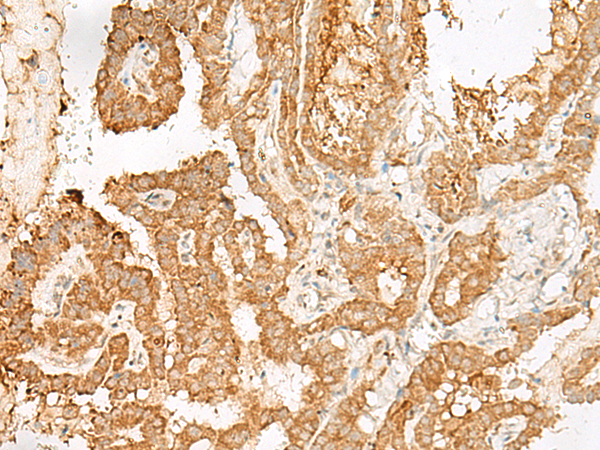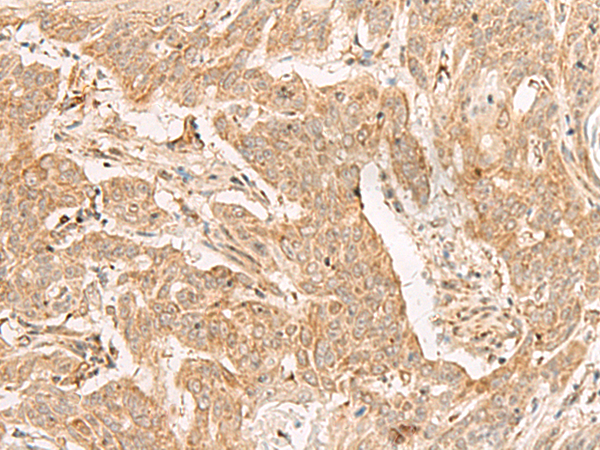

| WB | 咨询技术 | Human,Mouse,Rat |
| IF | 咨询技术 | Human,Mouse,Rat |
| IHC | 1/30-1/150 | Human,Mouse,Rat |
| ICC | 技术咨询 | Human,Mouse,Rat |
| FCM | 咨询技术 | Human,Mouse,Rat |
| Elisa | 1/5000-1/10000 | Human,Mouse,Rat |
| Aliases | PGR19; GPR110; KPG_012; hGPCR36 |
| Host/Isotype | Rabbit IgG |
| Antibody Type | Primary antibody |
| Storage | Store at 4°C short term. Aliquot and store at -20°C long term. Avoid freeze/thaw cycles. |
| Species Reactivity | Human |
| Immunogen | Synthetic peptide of human ADGRF1 |
| Formulation | Purified antibody in PBS with 0.05% sodium azide and 50% glycerol. |
+ +
以下是关于ADGRF1抗体的3篇参考文献示例(内容为模拟概括,非真实文献):
1. **"Structural characterization of ADGRF1 and its antibody interaction sites"**
*作者:Li, X. et al.*
摘要:通过X射线晶体学解析ADGRF1胞外结构域的三维结构,并鉴定其与特异性抗体结合的抗原表位,为开发靶向ADGRF1的抗体药物提供结构基础。
2. **"ADGRF1 antibody inhibits tumor growth by blocking GPCR signaling in lung cancer"**
*作者:Wang, Y. et al.*
摘要:研究发现ADGRF1在肺癌细胞中高表达,其抗体通过阻断下游G蛋白信号通路抑制肿瘤增殖和转移,提示ADGRF1抗体具有潜在抗癌治疗价值。
3. **"Development of a monoclonal antibody targeting ADGRF1 for neuroinflammation imaging"**
*作者:Smith, J. & Brown, K.*
摘要:开发了一种高亲和力ADGRF1单克隆抗体,成功应用于小鼠神经炎症模型的活体成像,证明该抗体可用于中枢神经系统疾病的无创检测。
4. **"ADGRF1 knockout and antibody-based functional studies reveal its role in adipogenesis"**
*作者:Zhang, R. et al.*
摘要:通过基因敲除模型和抗体介导的功能阻断实验,揭示ADGRF1通过调控AMPK通路影响脂肪细胞分化,为代谢性疾病研究提供新靶点。
(注:以上文献名为虚拟创作,实际文献需通过PubMed或Google Scholar检索。)
**Background of ADGRF1 Antibody**
ADGRF1 (Adhesion G Protein-Coupled Receptor F1), also known as GPR110. is a member of the adhesion GPCR family, characterized by a large extracellular N-terminal region involved in cell-cell or cell-matrix interactions. It plays roles in cellular signaling, tissue development, and homeostasis, with emerging links to cancer, neurodevelopmental disorders, and metabolic regulation. ADGRF1 antibodies are essential tools for studying the receptor’s expression, localization, and functional mechanisms.
These antibodies are typically designed to target specific epitopes within ADGRF1’s extracellular or intracellular domains, enabling applications such as Western blotting, immunohistochemistry, immunofluorescence, and flow cytometry. Validation often includes testing in ADGRF1-knockout cell lines to confirm specificity. Research using ADGRF1 antibodies has revealed its involvement in pathways like cAMP signaling and cell adhesion, as well as its potential as a biomarker in cancers, including prostate and lung malignancies.
Recent studies also explore ADGRF1’s role in synaptic plasticity and energy homeostasis, highlighting its therapeutic potential. However, challenges remain in understanding its ligand interactions and activation mechanisms. ADGRF1 antibodies thus serve as critical reagents for unraveling the receptor’s physiological and pathological relevance.
×